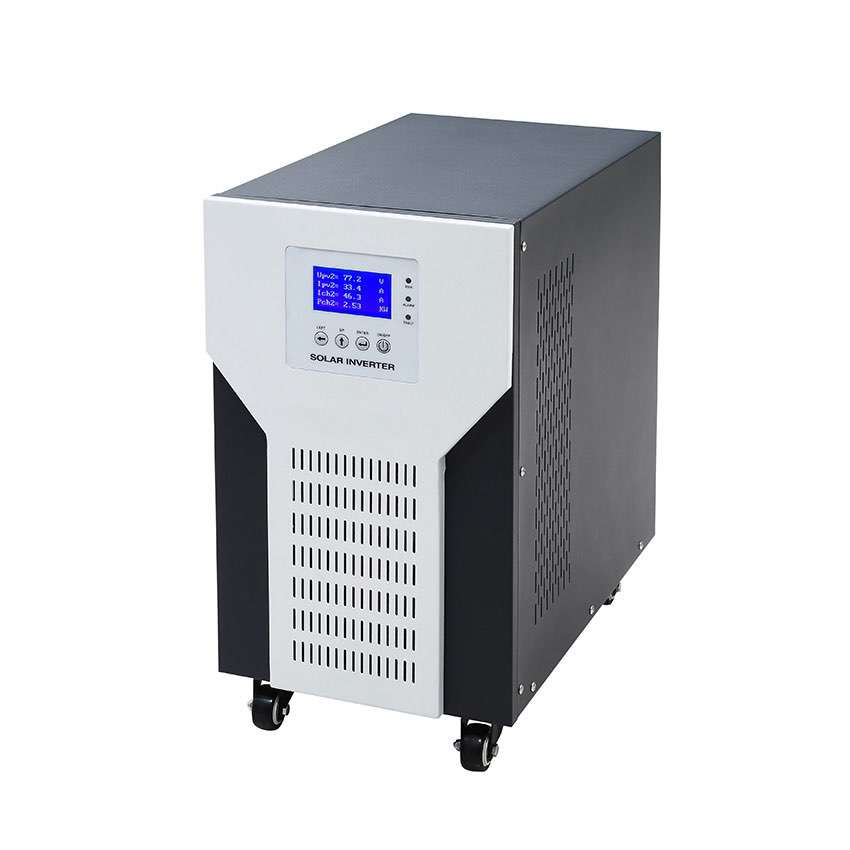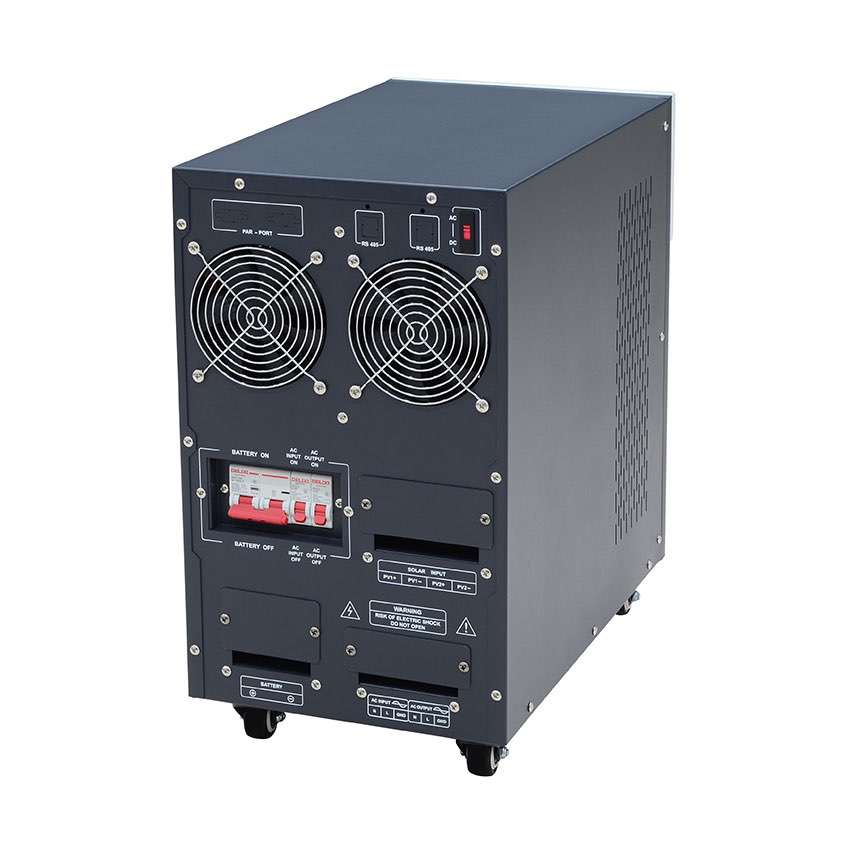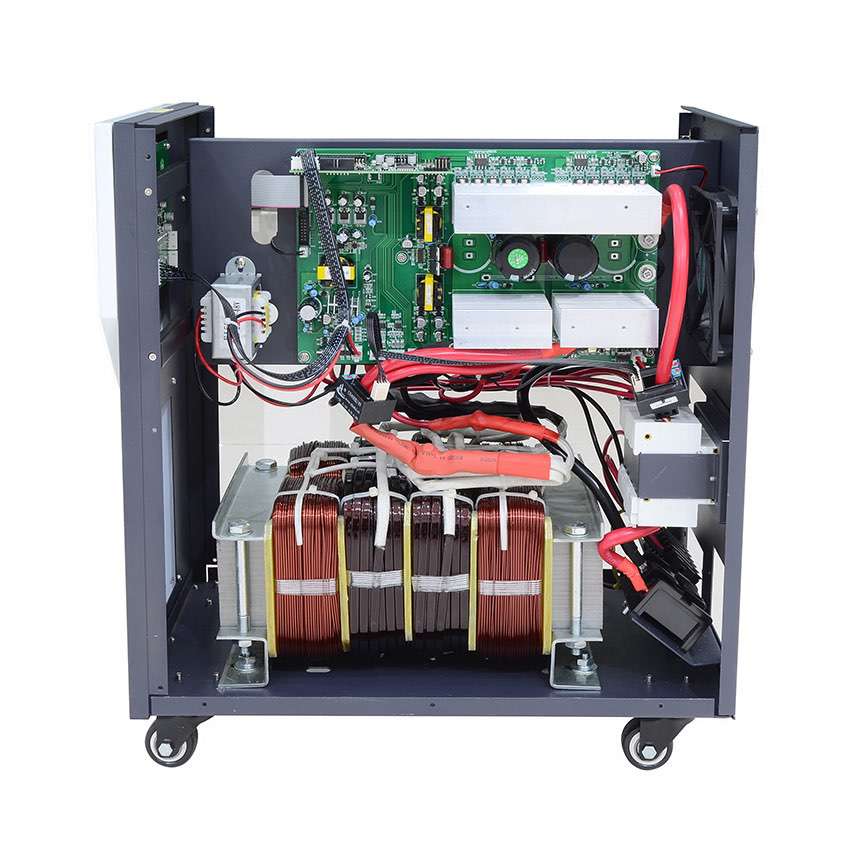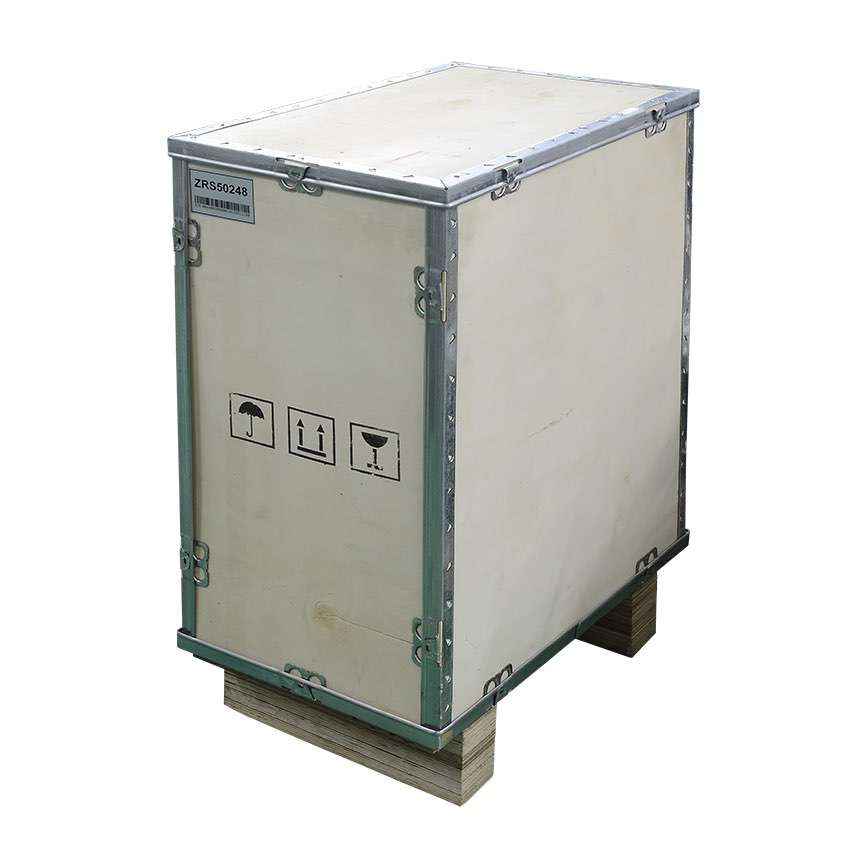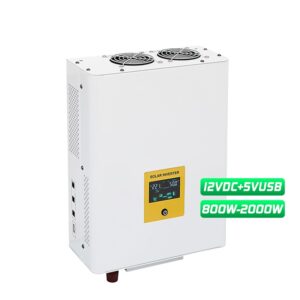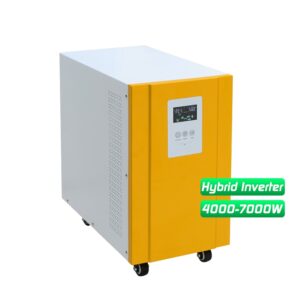
■ Solar Power Inverter Feature
1 Solar power inverter could be either with or without storage battery configuration, to reduce the cost of solar system;
2 Integrated intelligent energy management system, a variety of modes could be set;
3 Inverter has high transfer efficiency;
4 Ease city grid pressure, reduce electricity bills;
5 Dual MPPT input, precise algorithm, efficient use of PV energy;
6 Either diesel generator input or gasoline generator input is compatible with the system;
7 Isolated output of low frequency transformer, with strong impact resistance;
8 Large LCD screen, operating parameter could be displayed in real time;
9 Support multiple remote monitoring of communication software (RS485/Mobile APP(WIFI monitor or GPRS monitor)).
■ Solar Power Inverter Specification
| Specification | |||
| Model: ZRS | 30248 | 50248 | |
| PV Input | Max input voltage(Voc) (At the lowest temperature) |
150V | |
| MPPT tracking range | 60V-120V | ||
| Recommended operating voltage range |
60V-80V | ||
| MPPT route number | 2 | ||
| Max input power | 1960W/1960W | 3360W/3360W | |
| Battery (Flexible configuration) |
Type of battery | Lead-acid battery / Lithium-ion battery(Need to customize) | |
| Rated voltage | 48V | ||
| Max charging current (Can be set,Recommended 0.1C) |
70A(PV)/ 35A(Mains) | 120A(PV)/ 60A(Mains) | |
| Float voltage(Can be set) | 55.2V | ||
| Charge voltage(Can be set) | 56.8V | ||
| AC Input | Rated voltage | 220V/230V | |
| Input voltage range | 187V~264V | ||
| Rated input frequency | 45Hz~55Hz(50Hz)/55Hz~65Hz(60Hz) | ||
| Loss protection time | ≤2S | ||
| Reconnection time | 30S | ||
| AC Output (PV/Battery mode) |
Rated output power | 3000W | 5000W |
| Rated output voltage | 220V/230V | ||
| Output voltage accuracy | ±2% | ||
| Rated output frequency | 50Hz/60Hz | ||
| Output frequency accuracy | ±1% | ||
| AC Output (Mains mode) |
Rated output power | 3000W | 5000W |
| Output voltage | 187V~264V | ||
| Output frequency | 47~52Hz/57~62Hz | ||
| Regular Parameter |
Topology | Transformer isolation | |
| Display | LCD+LED | ||
| Communication(Optional) | RS485/Mobile APP(WIFI monitor or GPRS monitor) | ||
| Operating temperature | -20℃~60℃(Derating above 45°C) | ||
| Storage temperature | -20℃~60℃ | ||
| Noise | ≤60dB | ||
| Relative humidity | 20%~95%(No condensation) | ||
| Highest altitude | 2000m(More than derating) | ||
| Machine dimension(L*W*Hmm) | 467*280*508 | ||
| Package dimension(L*W*Hmm) | 530*340*635 | ||
| N.W(kg) | 40 | 49 | |
| G.W(kg) | 47 | 56 | |
| Installation Method | Tower | ||
| Note: All specifications are subject to charge without prior notice | |||
■ Why Use ZRS Solar Power Inverter?
1 Battery configuration is flexible
The old generation solar power inverters must be equipped with batteries to be used normally (and need to be equipped with large-capacity batteries)
1.In the total cost of solar energy system, the cost of batteries accounts for a higher proportion.
2.The battery is always in a deep discharge situation, shortening the battery life.
3.Maintenance and replacement are difficult.
4.Waste batteries cause serious pollution to the environment.
The new generation solar power inverter can be used normally without batteries
According to actual needs, the user no need to configure the battery, the solar power inverter will automatically start up in the solar energy state, and supply power to the load. Without the battery, the installation and maintenance of the solar energy system are simpler, which is conducive to reducing operating costs and reducing environmental pollution caused by waste batteries.
The new solar power inverter can be flexibly configured or not equipped with batteries:
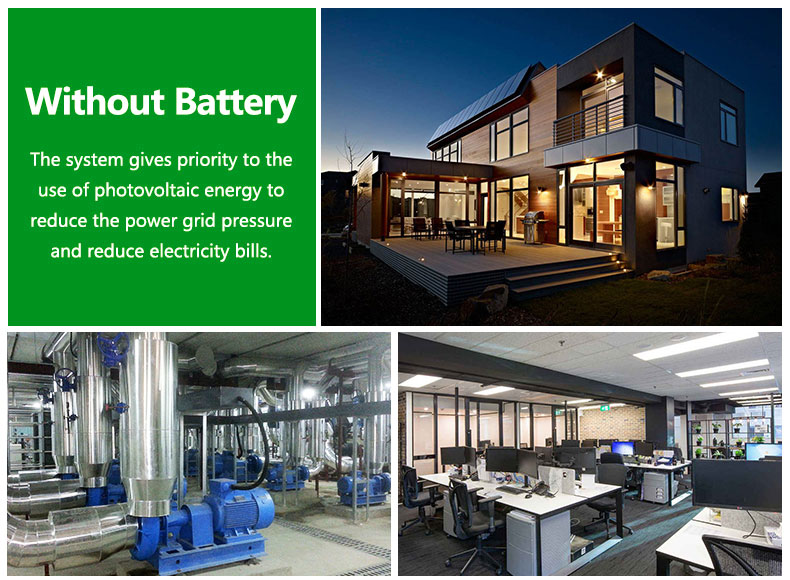


2 Working modes: gives priority to the use of solar energy
AC Priority Mode
The new generation solar power inverter
Solar — Power Grid — Battery
1.When the solar energy is sufficient, solar supplies energy to the load and also charges the battery.
2.When the solar energy is insufficient, solar and power grid supply energy to the load together, and the battery does not provide energy to the load.
3.When the solar energy is insufficient and the grid power is cut off, the solar and the battery will provide energy to the load together.
4. When the solar has no energy and the battery is discharged to the low-voltage protection point, the power grid supply energy to the load completely.
Advantages of the new solar power inverter\’s AC priority mode:
1.The solar energy system gives priority to the use of solar energy, and when the solar energy is not enough for the local load, it will be supplemented by the power gird, which can make full use of the solar energy.
2.In this working mode, the battery will only discharge when the solar energy is insufficient and the power grid fails. Under normal circumstances, the battery is always in a fully charged state, so it will greatly extend the life of the battery.
The old generation solar power inverter
1.When the power grid is normal, the load is all supplied with energy from the grid, and the solar energy will only charge the battery, and the remaining solar energy is wasted; if the battery is full, the solar energy is all wasted.
2.Only when the power grid is cut off, the load is powered by solar and batteries
Battery Priority Mode
The new generation solar power inverter
Solar — Battery — Power Grid
1.When the solar energy is sufficient, solar supplies energy to the load and also charges the battery.
2.When the solar energy is insufficient and the battery voltage is greater than 48V, the solar and the battery provide energy to the load together, and the power grid does not provide energy to the load.
3.When the solar energy is insufficient and the battery voltage is less than 48V, the inverter will control the battery to linearly reduce the output power, and only provide part of the power to the load. The remaining part will be provided by the power grid.
Advantages of new solar power inverter\’s battery priority mode:
1.The solar energy system gives priority to the use of solar energy, and the power grid is only used as the last supplementary power supply when the solar energy and battery are insufficient, which greatly reduces the user\’s electricity cost.
2.In this working mode, there is no frequent switching between the battery and the power grid, the battery has a small number of charging and discharging, and the life is relatively long.
3.Solar/battery and power grid complement each other perfectly, and the load power supply is stable.
The old generation solar power inverter
1.When the solar energy is sufficient, it supplies energy to the load and also charges the battery.
2. When the solar energy is insufficient, the solar and the battery provide energy for the load together.
3.When the solar energy is insufficient and the battery is discharged to the low-voltage protection point, it will switch to the power grid, and the grid will supply energy to the load, the solar will continue to charge the battery; When the battery voltage is charged to a certain value, the power supply from the grid to the load is switched to the solar and the battery for the load.
In this working mode, the battery and the power grid will switch back and forth. If the battery capacity is large, the switching time is long. If the battery capacity is small the time interval of switching back and forth is very short. This will cause the battery to be charged and discharged too many times and shorten the service life.
3. Off Grid Solar Energy System and On Grid Solar Energy System
The off grid solar energy system does not be connected to the grid. When the fault occurs in the power grid, the new generation solar power inverter can still work normally and provide energy to the load by solar energy or battery.
The on grid solar energy system must be connected to the grid. When the fault occurs in the power grid, the solar power system will get out operation and cannot provide energy to the load.
■ Solar Power Inverter Details


■ Solar Power Inverter Wiring Diagram 
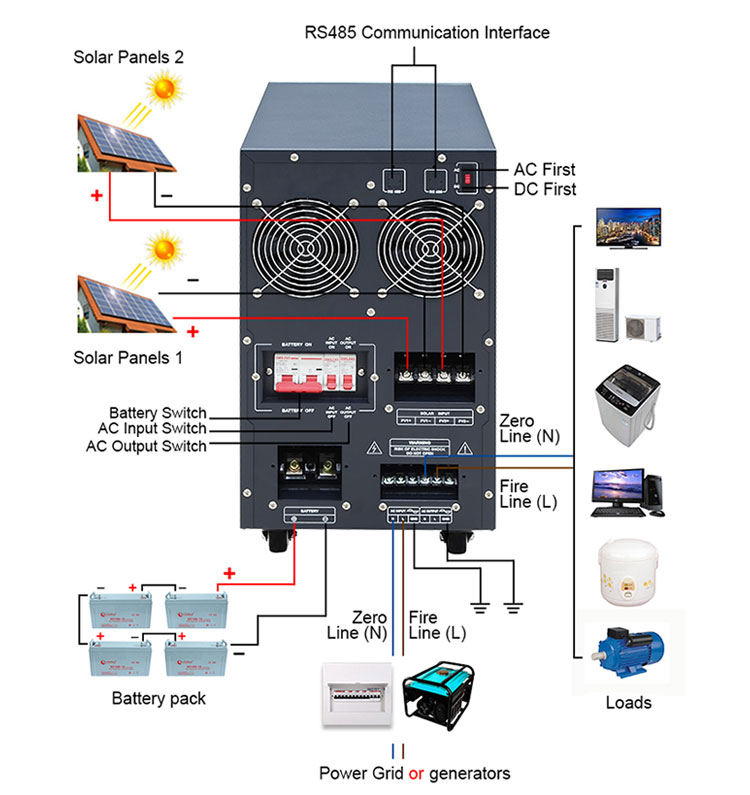
Here I introduce how the solar power inverter works: 
|
With power grid, solar energy, and batteries, inverter always uses solar energy first:
|
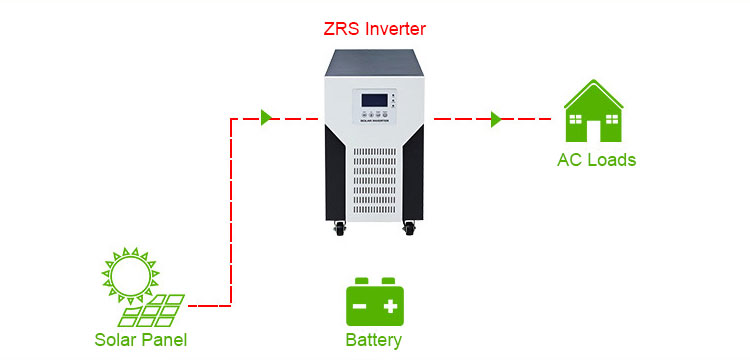
|
No power grid and batteries, but solar energy is available: The inverter automatically turns on and operates in the solar energy state, and the AC load is completely powered by the solar energy. If the solar power generation is 1000W, the total power of the AC load can only be ≤1000W, and over 1000W will trigger the overload protection. |

|
No solar energy and batteries, but power grid is available: The inverter automatically turns on and operates in the power grid state, and the AC load is completely powered by the power grid. If the power gird is powered off, the AC load cannot continue to operate.
|
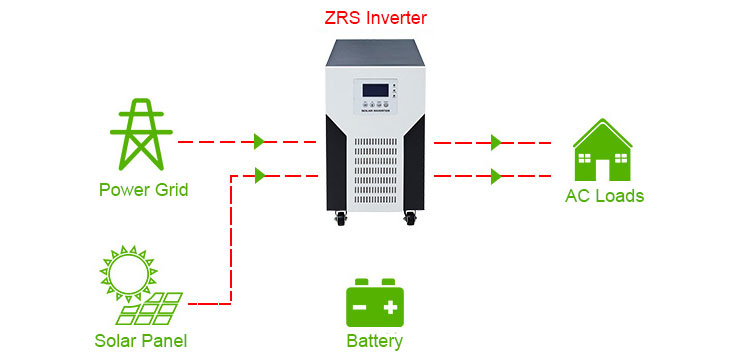
No battery, but power grid and solar energy is available, inverter always uses solar energy first:
1,If the solar power generation is 1000W, the AC load is 600W. The solar energy powers the AC load to 600W. At this time, the power grid does not provide energy.
2,If the solar power generation is 1000W, the AC load is 1600W. The solar energy supply 1000W and the power grid supply 600W for the AC load.
■ Solar Power Inverter Application

■ Inverter Package and Delivery 

